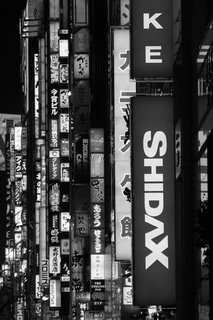Monday, January 23, 2006
Rikugien (Gardens)
 This weekend Tokyo received a rare heavy snow, driving most people indoors and photographers out. Rikugien, near Komagome, is one of Tokyo's nicest gardens and typically not crowded due to its location and lack of renown. It dates back to the Edo era, and became a public garden in 1938.
This weekend Tokyo received a rare heavy snow, driving most people indoors and photographers out. Rikugien, near Komagome, is one of Tokyo's nicest gardens and typically not crowded due to its location and lack of renown. It dates back to the Edo era, and became a public garden in 1938.Nature in Japan is venerated, as long as it is ordered and in some way satisfying to people. A Japanese garden is exquisitely sculpted to look "wild", but in a tightly controlled way. The truly wild and unruly in nature are far less highly regarded; mainly they are feared. This is understandable in an island nation historically subject to earthquakes, typhoons, tsunamis, and volcanic eruptions. It has also contributed, along with the rush to industrialization and a system biased toward big construction projects that distribute government funds in rural areas, to serious environmental devastation around the country.

Sunday, January 15, 2006
The Great Hanshin-Awaji Earthquake Memorial, Kobe

Ikasumi ventures outside of Tokyo to honor the city of Kobe. This week (17 January, 5:46 AM) will mark the 11th anniversary of the Great Hanshin-Awaji Earthquake. More than 6400 lost lives and 40,000 injuries resulted. Guide books focus on the city’s admirable recovery, and indeed if one just walks around looking superficially one will see a vibrant city with few indications of the relatively recent tragedy. Talking to even a few people, however, reveals a different story. Memories of the lost loved ones and friends remain fresh, and the economic effects on individuals persist (many are paying two mortgages - one for the destroyed home and one for the replacement, without help from the government). Still, the resilience of the Japanese people was as strong as ever, and more than one million people volunteered for relief efforts. At this museum one can, through virtual reality, get a small yet harrowing taste of what the earthquake felt and looked like. Even more powerful, though, is the opportunity to talk with local survivors and hear their stories. One is forced to think of the effects such a quake would have in far larger and denser Tokyo. The question is not whether this will happen, but when.

Monday, January 09, 2006
Wednesday, January 04, 2006
Kabukicho, Shinjuku

Kabukicho is Tokyo's best known red light district, though by no means exclusively that. There is no kabuki here, at least not the traditional kind, and evidently the name is residue from a time when the government considered rebuilding the kabuki-za in this area before eventually deciding to keep it in Ginza. Kabukicho has good cinemas and theaters, however, as well as restaurants and bars, in addition to its seedier entertainments. The kaleidoscope of neon, for starters, unbalances.

Yasukuni Dori Shopping Area, Shinjuku

The Yomiuri Shimbun reported that on January 2nd, the day all major stores commenced their New Year sales, twenty thousand people were lined up outside Mitsukoshi in Nihonbashi just before their 10:00 AM opening. Who could blame a clerk or cashier, learning of such an impending onslaught, for quietly slipping out the back door, never to return?






